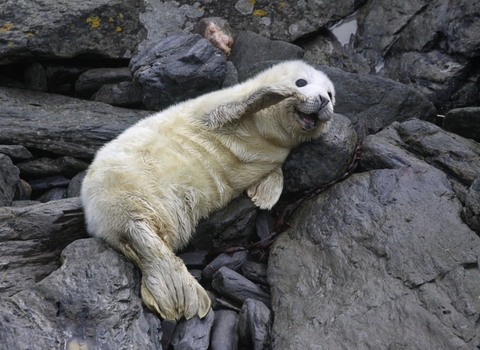
Grey Seal ©Chris Gomersall/2020VISION

Grey Seal ©Alex Mustard/2020VISION

Seal pup by Tom Marshall

© Eleanor Stone
Grey seal
Scientific name
Halichoerus grypusWhen to see
January to DecemberSpecies information
Category
Statistics
Length: up to 2.6m Weight: Males up to 300kg, females up to 200kg. Average Lifespan: 30-40 yearsAbout
The grey seal is the larger of the two UK seal species. If you catch a good look at them you’ll see how they got their scientific name Halichoerus grypus – it means hook-nosed sea pig! These mammals spend most of their time out at sea feeding on fish. They return to land to rest and can often be seen ‘hauled out’, lying on British beaches. Grey seals give birth to fluffy white pups in the autumn. These adorable pups stay on land until they have lost their white coats and trebled their body weight.How to identify
The grey seal can be distinguished from the common seal by its larger size and longer head with a sloping 'roman nose' profile. Looking straight on, their nostrils are parallel, rather than v-shaped as in common seals. Mainly grey in colour, the unique pattern of darker blotches and spots can be used to identify individuals.Distribution
Found all around the UK.In our area
The Isles of Scilly is considered regionally important for grey seals in the south west of England. The population fluctuates between 360 and 700 individuals throughout the year, making up part of the much larger Celtic Sea population. Grey seals haul themselves onto rocks and beaches, often in large numbers, to rest, breed, and digest their food. You can see them easily around the Isles of Scilly. Use binoculars to check sheltered bays and rocky outcrops, including Pelistry on St Mary's, Great Bay on St Martins and Great Par on Bryher. Alternatively, head out with a WiSe accredited boating provider to the Eastern Isles or Western Rocks.
There is always a chance that you might encounter a grey seal pup on a beach, particularly in the autumn. Find out more about what to do.
Did you know?
Despite numbers dropping to only 500 in the early 20th century, it's estimated that there are now more than 120,000 grey seals in Britain, representing 40% of the world's population and 95% of the European population.The Isles of Scilly is considered regionally important for grey seals in the south west of England. The population fluctuates between 360 and 700 individuals throughout the year, making up part of the much larger Celtic Sea population. Grey seals haul themselves onto rocks and beaches, often in large numbers, to rest, breed, and digest their food. You can see them easily around the Isles of Scilly. Use binoculars to check sheltered bays and rocky outcrops, including Pelistry on St Mary's, Great Bay on St Martins and Great Par on Bryher. Alternatively, head out with a WiSe accredited boating provider to the Eastern Isles or Western Rocks.
There is always a chance that you might encounter a grey seal pup on a beach, particularly in the autumn. Find out more about what to do.

